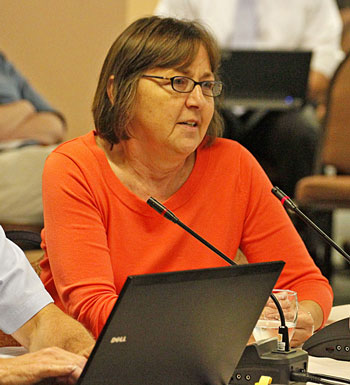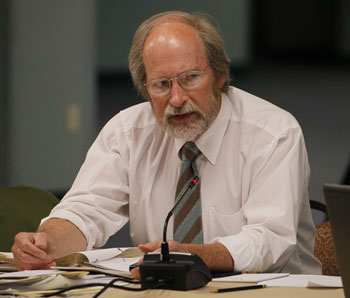Council Mulls Limited Access to Closed Areas
by Laurie Schreiber

We believed these closures would produce significant changes in the status of the resource. We have seen some of that with haddock but, unfortunately, we haven’t seen it with any of the other stocks. Maggie Raymond, Associated fisheries of Maine. © Photo by Sam Murfitt.
PLYMOUTH, Mass. – At its September meeting, the New England Fishery Management Council considered an action that would allow groundfish sectors to request exemption from the prohibition on fishing in year round closed areas, with some limitations.
The action is under consideration as part of Framework 48 of the groundfish management plan. The discussion came on the heels of initial meetings of the NEFMC’s Closed Area Technical Team (CATT), which has been reviewing Framework 48 measures that would allow groundfish sectors to request exemptions from non-essential fish habitat portions of the year-round groundfish closed areas, including Closed Area I, Closed Area II, the Nantucket Lightship Area, a slice of the Western Gulf of Maine Area, and the Cashes Ledge Closed Area.
As a second phase of work, the CATT will develop alternatives to complement and augment the habitat management areas for consideration in the NEFMC’s Essential Fish Habitat Omnibus Amendment. The latter phase includes consideration of rolling closures, spawning closures, as well as year-round closed areas. The initial work focused on further development and ranking of the potential impacts of closed areas for groundfish and other management to identify closed area objectives for groundfish ACL management.
Limitations to the proposal specify that access will only be granted for the parts of areas that are not defined as habitat closed areas, or that have not been identified as potential habitat management areas as part of the development of the Omnibus Habitat amendment; access to Closed Area 1 and Closed Area 2 will only be granted for the period May 1 through Feb. 15; and access to the Western Gulf of Maine Closed Area will only be granted during periods not subject to rolling closures that are applicable to sectors.
Maggie Raymond, executive director of Associated Fisheries of Maine (AFM) in South Berwick, told the NEMFC that, 18 years ago, AFM was in favor of the area closures.
“We were the only industry group to do that at that time,” Raymond said. “We were quite unpopular. We believed these closures would produce significant changes in the status of the resource. We have seen some of that with haddock but, unfortunately, we haven’t seen it with any of the other stocks, particularly in the Gulf of Maine, where these closures came in later with Gulf of Maine cod. We haven’t seen that the closures have produced the desired result. So in some ways we regret supporting these closures.”
Now, said Raymond, it’s time to provide access to the areas.
“What are the he options for the industry?” she said. “How do we bring more fish across the dock? How do we pay our bills? How do we support the infrastructure? How do we feed our families? This is an opportunity to bring more fish across the dock. That’s what we need to do.”
In some ways, she said, the action does not go far enough because it doesn’t provide relief from rolling closures for smaller boats.
“This is a very small opportunity here, in terms of access to areas that have been closed a very long time,” Raymond said. The action, she said, is in line with the sector system approach to co-management. After a year, she said, the industry and managers will be able to judge whether the action is fruitful.
“We went into this kicking and screaming,” she said of the sector system. “We’re trying make it work, but we need access to the resource to make it work.”
Emilie Litsinger, groundfish project manager with the Environmental Defense Fund’s Boston office, said the organization supports the proposal.
“The time is right to evaluate New England’s closed area network,” Litsinger said. “We support the council’s approach to consider the utility of closed areas for habitat and groundfish management in an integrated manner. While the larger analysis continues, we support this motion to consider exemption requests for individual sectors for access to groundfish closures.”
At the same time, said Litsinger, access should require 100 percent at-sea monitoring and, to continue, should clearly demonstrate that only healthy stocks are harvested, not weak stocks.
Roger Fleming, an attorney with the environmental organization EarthJustice, disagreed.
“This is a significant change to the [fishery management] plan,” Fleming said. As such, he said, there needs to be a full environmental impact analysis on the proposal.
“We think it’s reasonable to evaluate these closure now, but it should be done as part of a comprehensive approach,” Fleming said.
Jeff Smith, with the Nature Conservancy of Maine, said the NEFMC should also consider the potential implications for groundfish rebuilding efforts.
“The fishery has been declared a disaster. There are pretty heavy cuts in quota coming,” Smith said.
Smith asked the NEFMC to review a study, “Report of The Workshop on Stock Structure of Atlantic Cod in the Gulf of Maine Region,” published in June by the Gulf of Maine Research Institute, which examined fish populations inside and outside of groundfish closed areas. The study found that cod sampled inside closed areas are bigger, healthier and more productive. There are eight times as many fish five years or older inside than outside. The older age of the fish inside the closed areas has important implications for rebuilding efforts, Smith said, because of their higher productivity, better eggs, and better potential for survival of the eggs, compared with younger fish.
Aaron Dority, with the Stonington-based Penobscot East Resource Center, agreed with Smith, particularly with regard to the cod population around Cashes Ledge, which appears be distinct from cod populations elsewhere in the gulf. “Cashes may be a unique population,” Dority said. “I’m not saying don’t open a portion. But we should consider that.”
Others said they were concerned about the large number of “berried” – egg-carrying – female lobsters in the closed areas.
“We need to have some kind of seasonal closure out there,” said NEFMC member Doug Grout. “Given the large number of lobsters in that area, I can’t support this anymore. Originally, I was going to support as an option in the framework because what’s going to happen, potentially, in May 2013.”
But, said Grout, he was concerned about the impact of mobile gear on what appears to be large populations of spawning lobsters. Grout and others said it would be more appropriate to take up the matter as part of the NEFMC’s Essential Fish Habitat Omnibus Amendment 2, with its comprehensive process for environmental impact analysis, and which is currently on the docket. The omnibus amendment considers issues related to essential fish habitat in the fisheries for groundfish, sea scallop, monkfish, Atlantic herring, skates, Atlantic salmon, and Atlantic deep-sea red crab.
NEFMC member Mark Gibson said he supported groundfishing access to closed areas, in order to provide flexibility. But he said the NEFMC should proceed cautiously, because it does not yet have a full understanding of stock structures on a fine scale.
NEFMC David Goethel said he supported groundfish spawning closures. But, he said, if closures in general were effective, “we would have overflowing groundfish everywhere. Instead, we have a disaster. I think it’s time to admit when something doesn’t work.”

Pierce cautioned, one of the negatives could be that any vessel allowed access into a closed area through a sector operation plan exemption wouldn’t necessarily have an observer onboard. – NEFMC member David Pierce © Photo by Sam Murfitt.
“I’m open-minded on this issue,” said NEFMC member David Pierce.
Still, Pierce cautioned, one of the negatives could be that any vessel allowed access into a closed area through a sector operation plan exemption wouldn’t necessarily have an observer onboard.
“Maybe sectors would offer that up as an initial step – anyone going in would have an observer aboard,” Pierce said. “Otherwise, we wouldn’t get back any information about what’s going on. We would need to know what’s happening. I think that can be fixed.”
“This is not a fix-all. This will not make a terrible year okay,” said NEFMC member Tom Dempsey. “It will mitigate some of what we’ll see in 2013. I think there are real benefits and real risks. We’re likely to see some of those risks involved whether or not we can get sectors operational on May 1. Sectors will have to choose which exemption to pursue if we move this forward…. I only support moving forward with this because it will increase opportunities only where appropriate. I think we can expand harvesting opportunity only where sectors can demonstrate that they’re not undermining our other existing management obligations.”
In the end, the NEFMC agreed that the proposed action should also include consideration of the potential for gear conflicts, shifts in fishing effort out of the closed areas and impacts on protected species and lobsters.
Bonnie Spinazzola, executive director of the Bedford, N.H.-based Atlantic Offshore Lobstermen’s Association, said her organization supported the amended provision.
“This is something we are working toward with the groundfish fleet and hopefully with the scallop fleet,” Spinazzola said. “This is an area that we need to protect during a certain time and, the rest of the time, we support the groundfishermen getting in there.”
Jackie O’Dell, executive director of the Gloucester, Mass.-based Northeast Seafood Coalition, also spoke in support. “Especially in light of the disaster declared in this fishery, we’ve got to find opportunities to target this stock,” O’Dell said.
Among other measures for Framework 48, the NEFMC approved a motion asking the U.S. representatives to the U.S./Canada Steering Committee to negotiate a one-time request to trade an amount of Georges Bank haddock from the 2013 U.S. share in return for an amount of Georges Bank yellowtail flounder from the Canadian’s 2013 share.
The NEFMC approved the 2013 quotas for stocks governed by the U.S./Canada Resource Sharing Understanding for analysis. The NEFMC voted to include an option that would set the scallop fishery’s Georges Bank yellowtail flounder sub-ACL (a portion of the overall yellowtail annual catch limit) at a level between 8 percent and 16 percent.
The NEFMC is scheduled to take final action on Framework 48 at its November meeting.
